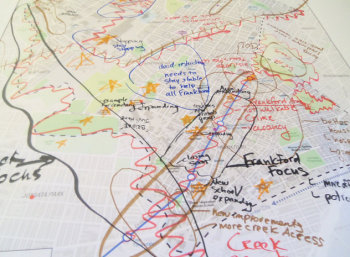City Planning Commission holds second Lower Northeast District meeting

The Philadelphia City Planning Commission held its second public meeting for the Lower Northeast District. Residents from the five neighborhoods of Frankford, Northwood, Oxford Circle, Lawncrest and Summerdale met at Saint Martin of Tours School recently to learn and discuss the possible future of their neighborhoods. The district plan is one small part of the city’s comprehensive plan, Philadelphia2035. The first meeting was held in April.
The meeting was conducted with a very hands-on approach setting up small group forums to enable all attending opportunities to listen and speak. Those attending, situated around five tables, held small discussions regarding many various issues ranging from transportation to recreation.
When discussing current conditions along Roosevelt Boulevard, many expressed the need for a better public transportation system in the area, such as a subway or monorail.
Jennifer Barr, a planner for the City Planning Commission, said the agency wanted to know how people felt about transit.
Frankford resident Doug Bryant welcomed the idea of a monorail line over the Boulevard. “I’m thinking rails, you’re talking 20 years from now. I’ll stick around to 2035 for that,” he said.
Bryant said he is attending these commission meetings to stay informed, trying to add his input to help revitalize Frankford.
“We lived here all our lives, and Frankford Avenue is only like, 1 percent of what it once was,” he said.
Tom Garland, also of Frankford, discussed the shift in Frankford Avenue’s businesses and culture.
“Frankford used to be a destination spot for people all over the city, not just the Northeast,” he said. “Then people began moving to the suburbs and industry also moved to the suburbs.”
Additionally, Garland explained that a shift occurred when stores like Sam’s Club and Home Depot moved in, forcing many private and locally owned businesses to close.
Barr said one of the reasons why discussing the Philadelphia2035 plan is so important in Philadelphia is due to a drastic demographic change from the 1980s. She said she thinks it is pertinent for the city to react so it can accommodate possible new demands.
“In the Lower Northeast there are a lot more immigrant groups and a lot of families that may not have the facilities they need,” she said.
One concern Garland voiced was this preliminary planning may not ever get implemented.
“The people in power and the ones who will be in power in the future need to see the plan, start making changes now and not wait until 2034 to start.”
Barr explained that although this committee is being very proactive with producing progressive city plans, the results will not happen overnight.
“Each plan takes eight to nine months to process and we have 18 districts to plan for.”
Barr said this phase of the 2035 plan is not projected to end for another six to seven years. Then the plan has to go through another zoning phase before implementation.
After the planning for this district commences, the City Planning Committee will not come back to cover other sections of Northeast Philadelphia for at least another year. For this reason, Barr said she hopes to see more residents from all of the Northeast to come out and voice their concerns at their next public meeting in August.
Erin Dungee and Laura Robb are students reporting for Philadelphia Neighborhoods, the publication of Temple University’s Multimedia Urban Reporting Lab.
WHYY is your source for fact-based, in-depth journalism and information. As a nonprofit organization, we rely on financial support from readers like you. Please give today.



